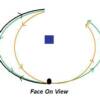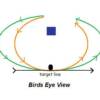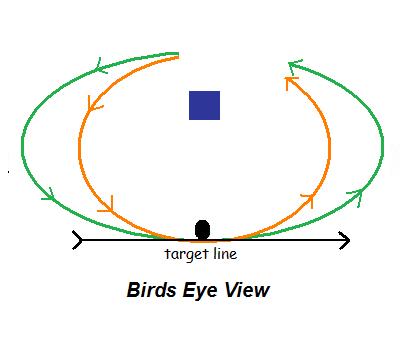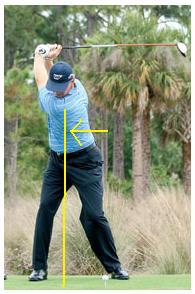Why Change?
Over the years, I have acquired a lot of knowledge pertaining to the golf swing from my own personal experience, watching my peers play, watching my peers teach, playing golf with my members and teaching my students. Knowledge is key component of the learning process. My view and theory of the golf swing is evolving as well. Successful golf swings and the perception of a successful golf swing change, folks. Equipment has a tremendous amount to due with this. Metal woods didn't become mainstream until the late 80's. Oversized titanium woods arrived in the 90's. Multilayer golf balls caught on around the turn of the millennium. Prior to all of this, small wood clubheads and wound golf balls were the norm. These wood clubheads had much more 'roll & bulge' incorporated into the design (than today's equipment) so a more inside path was needed at impact to allow and manage golf ball curvature. With today's clubhead design there is much less 'roll & bulge' with larger sweetspots. This produces less spin. Plus, the multilayer golf ball design used by everyone nowadays spins much less than the old 'wound' balls of yesteryear. Basically, a much more 'down the line' impact path is necesary with today's equipment.
What is the result of this tech boom? Today's game is all about power. Look at the top 20 world rankings (as of Nov 2011, when I published this site). David Toms, Luke Donald, Steve Stricker, and Matt Kuchar are the only players to crack the top 20 not considered 'long' off the tee. Sticker is the longest of these 4... he is ranked 113th in driving distance. Fifteen golfers in the top 20 in the world rankings are long hitters (Nov 2011). Contrary to what many people believe... the current equipment has made golfers more accruate more so than longer. Let me explain. EVERYONE has reaped the rewards of distance with the new equipment. So comparably speaking... there has been little distance gain (if any) amongst each other when comparing people (I hit the ball about 20 yards longer than I did in 1988... so have you, I'm sure). Now... I hit more fairways off the tee than I did in 1988. Straight/accurate hitters from 1988 really can't say they are straighter...because they always hit fairways to begin with. So... who has gained an edge? The 'bomber' has and it more evident on tour now than ever. Current/new golf equipment has made the 'bomber' tour professional much more accurate then the 'bomber' of yesteryear. So much so, they dominate the world rankings (and will continue to do so).
Now...look at the world rankings of yesteryear (circa 1980). We'll use the PGA tour money ranking in 1980. The world golf rankings didn't exist at this time but it is/was fair to say in 1980 and earlier years that the best golfers in the world played on the PGA tour. Only 1 player was ranked in the top 20 money winners in 1980 that was also ranked in the top 20 in distance, Jack Nicklaus. It was a different game back then. The 'short/accurate' golfer was the dominating force in the golf world as a whole. Now, technology advances has helped the long hitter to become more accurate and it has changed the demographics of the world golf stage. The taller you are the easier it will be to swing the golf club efficiently with with more clubhead speed (long levers, big arc). On the 1980 top 20 money list... only 4 golfers were 6' or taller. In the 2011 top 20 money list (when I published this site) ...14 golfers were 6' and taller (Nov 2011). That's a HUGE difference! I pulled all this data and collected it for my PGAPGM level 3 paper upon becoming a PGA professional. You can find all this data at the pgatour website.
What does this mean? Well, it affects how we teach the game of golf. Golf is a power game now and will continue to be so until the USGA/R&A 'retro' back some of the equipment parameters (which I don't personally see happening... which, in my opinion, very sad). As golf instructors, we must encourage our students to 'hit it hard'. My swing technique... 'The On Plane Swing' emphasizes efficient physical swing movements. That being said...distance can be achieved by getting physically stronger and faster with your swing movements, but the technique won't vary. With the 'On Plane Swing' I discourage tremendous down lag in the forward swing. There is lag in the 'On Plane' swing but do not confuse it with 'super' late downlag (and please don't confuse in any way with casting). The clubhead speed gained by the super late lag is enviable, but is offset by the unpredictable late release and the ABSOLUTE necessary timing that is needed (much less efficient result: 2 way miss). For clubhead speed, I stress a stronger body and faster movement to increase clubhead speed versus a change in technique.. 8 days a week and twice on Sunday. Or, if you are the physically fortunate.... the taller you are, the longer levers you posses, the bigger arc you will have and bingo... the more clubhead speed you 'potentially' posses.
Now lets's get back to the original question...why change? With the 'On Plane' swing, the clubhead is traveling the target line for a longer duration before, during, and after impact compared to traditional methods. That being said, golf ball curvature is much less. Geometrically speaking... the 'On Plane' swing has widened out the arc during impact. Where as the 'Hogan Arc', the 'One Plane Arc', and the 'Stack & Tilt Arc' the clubhead travels on the target line for a SHORTER duration (this promotes more curvature).
Because of the dynamic transfer of weight of the upper body during the forward swing, the 'On Plane Swing' technique is MUCH less stressful on the lower back than other golf swing techniques. There is much less 'Reverse C' impact or finish position. This alone is a great motivator to change. The 'On Plane Swing' will prolong your golfing career. I know of this personally. At age 29, I was 5'11" and 180 lbs. My clubhead speed was 119mph with a driver. My stock 9 iron was 158 yards. I had tremendous down lag in my forward swing to achieve this. As a result, I hit the ball low, extremely long, and crooked unless my timing was perfect. My reverse 'c' finish put a lot of stress on my lower back at the age of 29. Now, 12 years removed, my club head speed is 113mph, I still hit it far (not as far I used to), higher, straighter, and with a LOT less stress on my lower back (no reverse 'C' finish)
- Green: 'On Plane' Forward Swing Arc.
- Orange: 'Traditional' Forward Swing Arc.
- Notice: 'On Plane' Arc will travel on the 'target line' more than 'Traditional' Arc
Ernie Els' DYNAMIC TRANSFER OF WEIGHT
- Upper body moves laterally away from
- Upper body moves laterally towards the target during
- More 'level' position at impact
- Clubhead travels on target line during impact for
- Vertical upper body finish
- Less lower back pain







